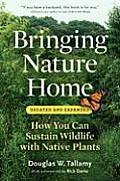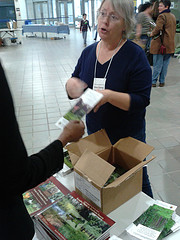 The Valdosta Tree Commission is offering Chaste trees
“to citizens at wholesale prices with the hopes of planting 100 trees in the city limits”, but this may actually be a bad idea, since this
species is exotic, does not support local insects and birds,
and in Texas has become invasive.
The Valdosta Tree Commission is offering Chaste trees
“to citizens at wholesale prices with the hopes of planting 100 trees in the city limits”, but this may actually be a bad idea, since this
species is exotic, does not support local insects and birds,
and in Texas has become invasive.
The Tree Commission’s writeup says this tree:
“has no serious pest problems and attract butterflies to the garden.”
 That first phrase is a red flag after reading
Dr. Douglas Tallamy’s book, Bringing Nature Home: How You Can Sustain Wildlife with Native Plants.
Local insects mostly cannot eat exotic plants,
and local birds eat local insects, so planting exotic trees
may look good, but is not helpful to native insects and birds.
Yes, Chaste trees may attract some butterflies,
but how many, compared to native trees?
And “no serious pest problems” means not many native insects munching
on the leaves or stems of the tree.
That first phrase is a red flag after reading
Dr. Douglas Tallamy’s book, Bringing Nature Home: How You Can Sustain Wildlife with Native Plants.
Local insects mostly cannot eat exotic plants,
and local birds eat local insects, so planting exotic trees
may look good, but is not helpful to native insects and birds.
Yes, Chaste trees may attract some butterflies,
but how many, compared to native trees?
And “no serious pest problems” means not many native insects munching
on the leaves or stems of the tree.
So what to plant instead?
See
next post.
The City of Valdosta posted PR 3 January 2013,
VTC Offers Chaste Trees at Wholesale Prices to Encourage Tree Planting,
Continue reading →
 I spoke to Karan Rawlins of the
Center for Invasive Species and Ecosystem Health
(bugwood.org)
at the
SoGa Growing Local & Sustainable Conference
in Tattnall County 26 January 2013 (coming to Lowndes County next year).
I spoke to Karan Rawlins of the
Center for Invasive Species and Ecosystem Health
(bugwood.org)
at the
SoGa Growing Local & Sustainable Conference
in Tattnall County 26 January 2013 (coming to Lowndes County next year).
 At the mention of
Chaste Tree, she picked up a copy of
A Homeowner’s Guide to Preventing the Introduction and Spread of Invasive Plants in Georgia,
and turned to page 6, which says:
At the mention of
Chaste Tree, she picked up a copy of
A Homeowner’s Guide to Preventing the Introduction and Spread of Invasive Plants in Georgia,
and turned to page 6, which says:


